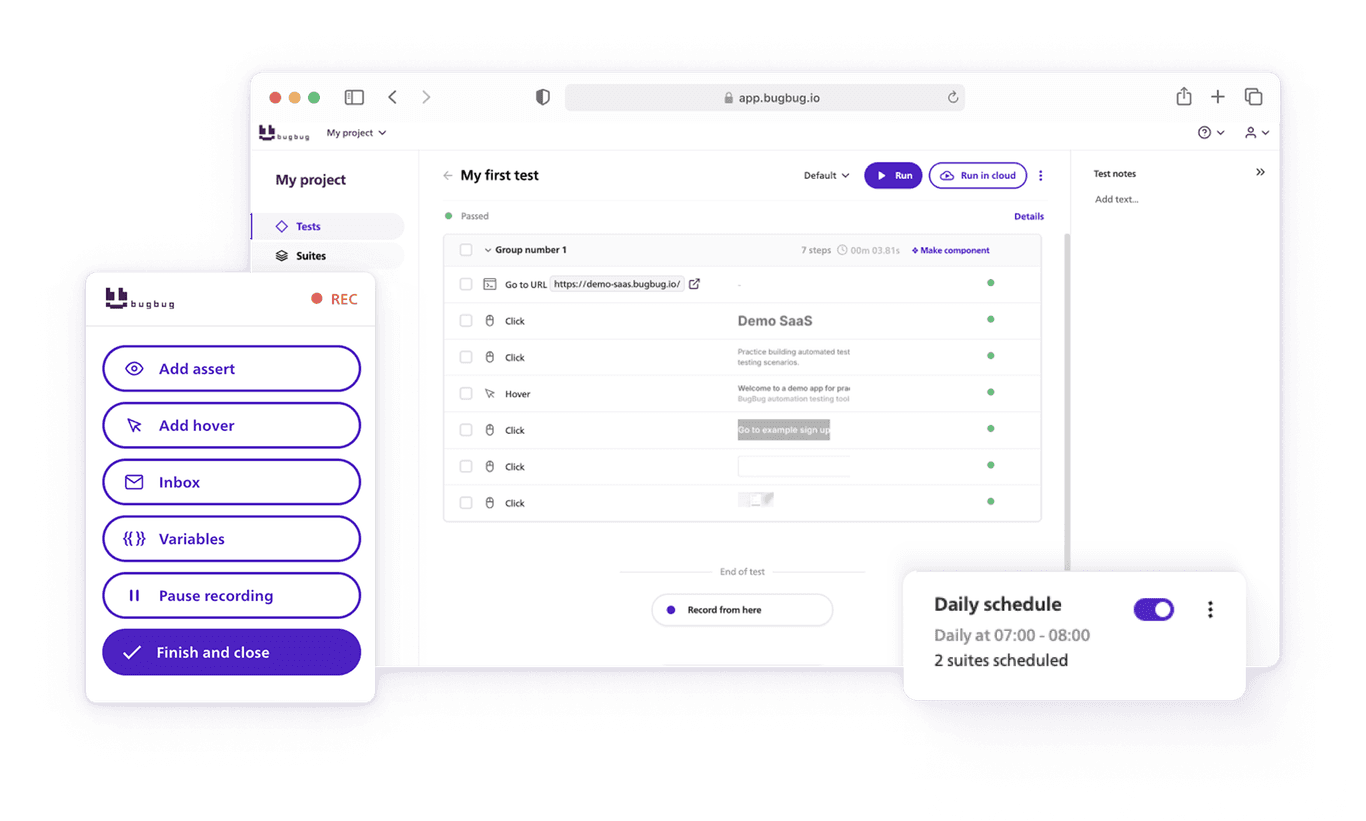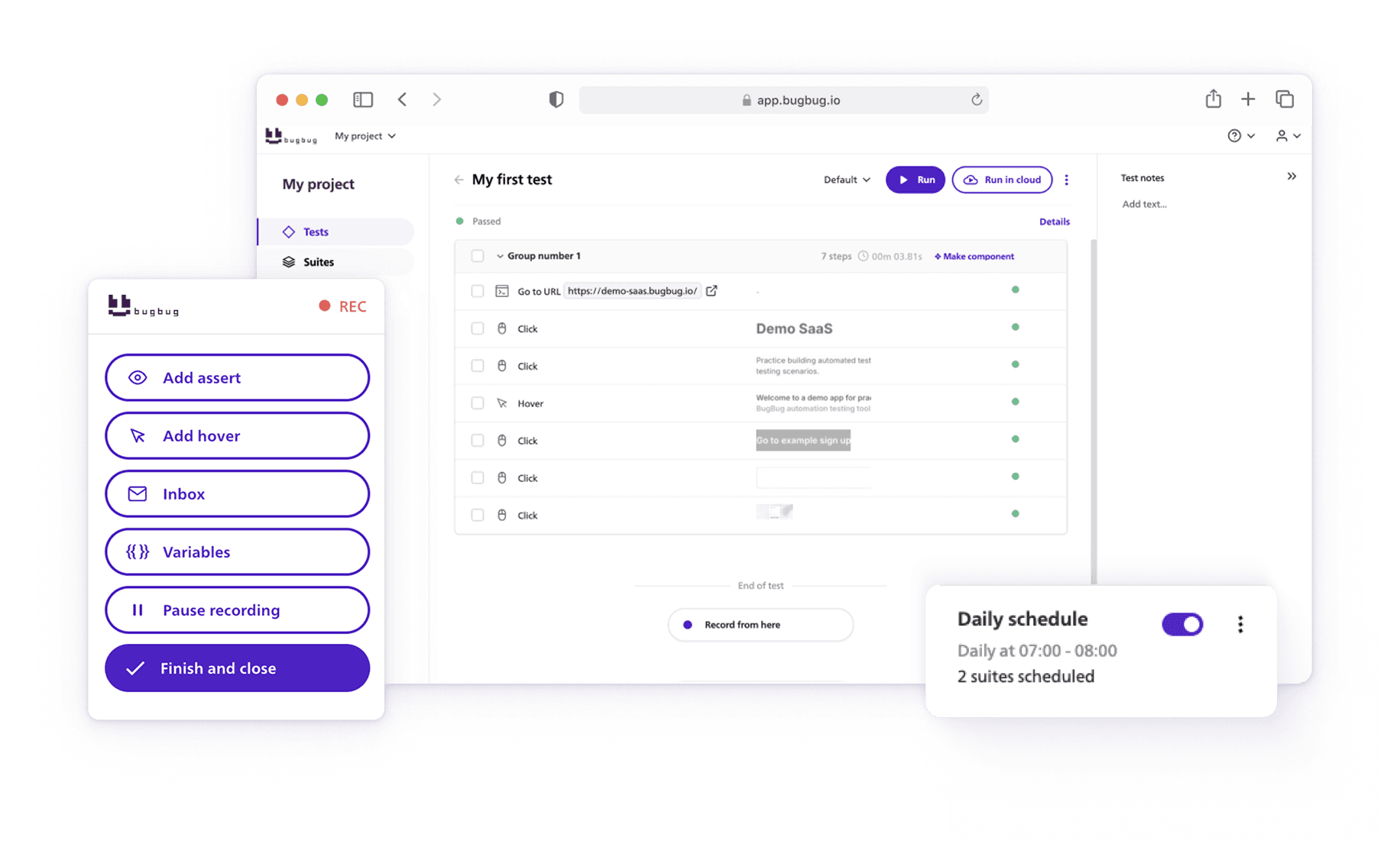🤖 Summarize this article with AI:
💬 ChatGPT 🔍 Perplexity 💥 Claude 🐦 Grok 🔮 Google AI Mode
There’s a dirty secret in test automation that nobody likes to admit: most automated tests are 80% copy-paste.
Login flows—navigation to dashboards. Filling out the same signup form a hundred times. As products grow, so do test suites—and suddenly, your team is spending more time maintaining brittle scripts than actually testing new features.
It’s the testing equivalent of doing laundry by hand when you already own a washing machine.
That’s exactly the problem BugBug’s Reusable Components are built to solve.
Check also:
The Maintenance Trap
If you’ve worked on a QA team for any length of time, you’ve seen it:
- The signup button changes its CSS selector. Suddenly 42 tests break.
- Marketing updates the login page. Now your regression suite throws red flags like a Christmas tree.
- A product manager asks why "simple test automation" seems to consume two full-time engineers.
What should be a straightforward process turns into a Sisyphean cycle of recording, editing, and re-recording steps.
The culprit? Duplication.
Every time you manually re-record the same sequence—logging in, visiting a page, setting a variable—you’re locking yourself into hours of future maintenance debt.
Enter Reusable Components: Your Automation Lego Bricks
BugBug’s Components feature is like handing QA teams a box of Lego bricks instead of loose gravel.
Instead of rebuilding the same steps across dozens of tests, you encapsulate them into a single reusable unit—a component.
For example:
- Create a Login as Admin component with steps to visit /login and enter valid credentials.
- Drop it into any test where admin access is required.
- Change the login selector once, and all your dependent tests update instantly.
It’s not just convenient. It’s transformational.
Why Components Are a Force Multiplier
Let’s quantify the time savings with a real-world example.
Say you manage 100 automated tests. Forty of them start with a login flow.
Without components:
- One CSS selector changes → You edit 40 tests individually.
- Estimated time: 10 minutes per fix × 40 = 6.5 hours wasted.
With components:
- Update once → All 40 tests inherit the fix.
- Time spent: 3 minutes.
Multiply that by every repeated action across your suite—signup flows, checkout funnels, navigation menus—and suddenly you’re reclaiming entire workdays every month.
This isn’t just about efficiency. It’s about sanity.
Beyond the Basics: Advanced Power Moves with Components
Reusable Components aren’t just about avoiding copy-paste. They unlock new strategic patterns for building scalable test automation:
1. Parametrized Components
A single Login component can cover multiple user roles. Just define {{login}} and {{password}} variables, override them per test, and reuse the same login flow for admins, editors, and regular users.
Think of it as writing one function instead of ten almost-identical ones.
2. Unlinking for One-Off Exceptions
Need to tweak a flow for a single edge case? Unlink the component. It becomes a standalone group you can modify without impacting other tests.
This keeps your system flexible, instead of rigid and fragile.
3. Splitting Components
Perhaps your Checkout Flow component is becoming too cumbersome. Split it into Add to Cart and Complete Payment. Both get automatically updated across all tests where they’re used.
It’s modularization—just like in clean code.
4. Bulk Management
BugBug gives you a centralized Components page where you can:
-
See which components are used most often (and where).
-
Duplicate, rename, or delete them in bulk.
-
Quickly identify and fix high-impact components (e.g., your login flow) before they cause cascading failures.
This is test automation with a product manager’s eye for leverage.
Real Talk: The Psychology of QA Fatigue
Here’s something we don’t talk about enough: test automation fatigue is real.
When engineers or QA specialists spend half their time firefighting broken tests, motivation plummets. Test suites get ignored. Bugs slip into production.
Reusable Components aren’t just a technical feature. They’re a morale booster. They reduce the “ugh factor” of maintenance, freeing teams to focus on strategic testing—exploring edge cases, improving coverage, and delivering real confidence in releases.
The Bigger Picture: QA as a Strategic Lever
At a macro level, components shift the role of QA from reactive to proactive.
Instead of being the team that always says, “Wait, our tests are broken again,” you become the team that says:
- “We can scale this suite without doubling maintenance.”
- “Our regression runs are stable and fast.”
- “We caught the bug before it reached staging.”
That’s not just saving time—it’s building trust across your product organization
Takeaway
If test automation is supposed to free teams from manual drudgery, then Reusable Components are the feature that frees automation from its own drudgery.
They let you:
- Cut hours of repetitive maintenance.
- Scale test suites without scaling headaches.
- Bring modularity and sanity to automation just like modern software engineering.
In short: components turn your test suite into a living system, not a brittle pile of scripts.
If you haven’t started using them in BugBug yet, now’s the time. Your future self—the one not spending Friday night fixing 40 broken login tests—will thank you.
👉 Curious how to start? Open the Components tab in BugBug and create your first one today. It’s a five-minute investment that could save you five hours next week.
Happy (automated) testing!



